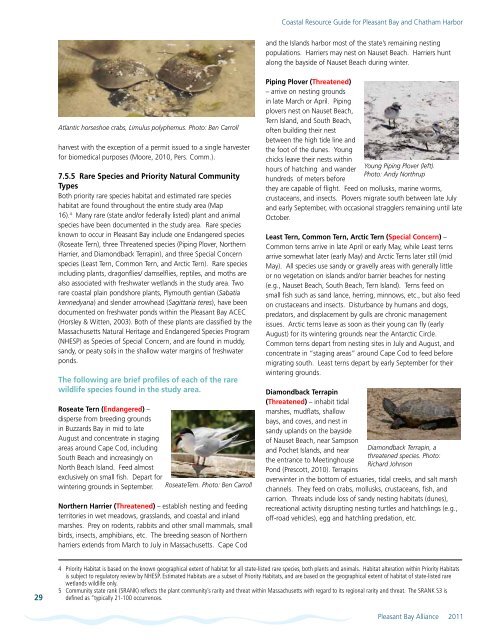Coastal Resource Guide Pleasant Bay and ... - Town to Chatham
Coastal Resource Guide Pleasant Bay and ... - Town to Chatham
Coastal Resource Guide Pleasant Bay and ... - Town to Chatham
You also want an ePaper? Increase the reach of your titles
YUMPU automatically turns print PDFs into web optimized ePapers that Google loves.
<strong>Coastal</strong> <strong>Resource</strong> <strong>Guide</strong> for <strong>Pleasant</strong> <strong>Bay</strong> <strong>and</strong> <strong>Chatham</strong> Harbor<strong>and</strong> the Isl<strong>and</strong>s harbor most of the state’s remaining nestingpopulations. Harriers may nest on Nauset Beach. Harriers huntalong the bayside of Nauset Beach during winter.Atlantic horseshoe crabs, Limulus polyphemus. Pho<strong>to</strong>: Ben Carrollharvest with the exception of a permit issued <strong>to</strong> a single harvesterfor biomedical purposes (Moore, 2010, Pers. Comm.).7.5.5 Rare Species <strong>and</strong> Priority Natural CommunityTypesBoth priority rare species habitat <strong>and</strong> estimated rare specieshabitat are found throughout the entire study area (Map16). 4 Many rare (state <strong>and</strong>/or federally listed) plant <strong>and</strong> animalspecies have been documented in the study area. Rare speciesknown <strong>to</strong> occur in <strong>Pleasant</strong> <strong>Bay</strong> include one Endangered species(Roseate Tern), three Threatened species (Piping Plover, NorthernHarrier, <strong>and</strong> Diamondback Terrapin), <strong>and</strong> three Special Concernspecies (Least Tern, Common Tern, <strong>and</strong> Arctic Tern). Rare speciesincluding plants, dragonflies/ damselflies, reptiles, <strong>and</strong> moths arealso associated with freshwater wetl<strong>and</strong>s in the study area. Tworare coastal plain pondshore plants, Plymouth gentian (Sabatiakennedyana) <strong>and</strong> slender arrowhead (Sagittaria teres), have beendocumented on freshwater ponds within the <strong>Pleasant</strong> <strong>Bay</strong> ACEC(Horsley & Witten, 2003). Both of these plants are classified by theMassachusetts Natural Heritage <strong>and</strong> Endangered Species Program(NHESP) as Species of Special Concern, <strong>and</strong> are found in muddy,s<strong>and</strong>y, or peaty soils in the shallow water margins of freshwaterponds.The following are brief profiles of each of the rarewildlife species found in the study area.Roseate Tern (Endangered) –disperse from breeding groundsin Buzzards <strong>Bay</strong> in mid <strong>to</strong> lateAugust <strong>and</strong> concentrate in stagingareas around Cape Cod, includingSouth Beach <strong>and</strong> increasingly onNorth Beach Isl<strong>and</strong>. Feed almostexclusively on small fish. Depart forwintering grounds in September.RoseateTern. Pho<strong>to</strong>: Ben CarrollNorthern Harrier (Threatened) – establish nesting <strong>and</strong> feedingterri<strong>to</strong>ries in wet meadows, grassl<strong>and</strong>s, <strong>and</strong> coastal <strong>and</strong> inl<strong>and</strong>marshes. Prey on rodents, rabbits <strong>and</strong> other small mammals, smallbirds, insects, amphibians, etc. The breeding season of Northernharriers extends from March <strong>to</strong> July in Massachusetts. Cape CodPiping Plover (Threatened)– arrive on nesting groundsin late March or April. Pipingplovers nest on Nauset Beach,Tern Isl<strong>and</strong>, <strong>and</strong> South Beach,often building their nestbetween the high tide line <strong>and</strong>the foot of the dunes. Youngchicks leave their nests withinhours of hatching <strong>and</strong> w<strong>and</strong>erhundreds of meters beforethey are capable of flight. Feed on mollusks, marine worms,crustaceans, <strong>and</strong> insects. Plovers migrate south between late July<strong>and</strong> early September, with occasional stragglers remaining until lateOc<strong>to</strong>ber.Least Tern, Common Tern, Arctic Tern (Special Concern) –Common terns arrive in late April or early May, while Least ternsarrive somewhat later (early May) <strong>and</strong> Arctic Terns later still (midMay). All species use s<strong>and</strong>y or gravelly areas with generally littleor no vegetation on isl<strong>and</strong>s <strong>and</strong>/or barrier beaches for nesting(e.g., Nauset Beach, South Beach, Tern Isl<strong>and</strong>). Terns feed onsmall fish such as s<strong>and</strong> lance, herring, minnows, etc., but also feedon crustaceans <strong>and</strong> insects. Disturbance by humans <strong>and</strong> dogs,preda<strong>to</strong>rs, <strong>and</strong> displacement by gulls are chronic managementissues. Arctic terns leave as soon as their young can fly (earlyAugust) for its wintering grounds near the Antarctic Circle.Common terns depart from nesting sites in July <strong>and</strong> August, <strong>and</strong>concentrate in “staging areas” around Cape Cod <strong>to</strong> feed beforemigrating south. Least terns depart by early September for theirwintering grounds.Diamondback Terrapin(Threatened) – inhabit tidalmarshes, mudflats, shallowbays, <strong>and</strong> coves, <strong>and</strong> nest ins<strong>and</strong>y upl<strong>and</strong>s on the baysideof Nauset Beach, near Sampson<strong>and</strong> Pochet Isl<strong>and</strong>s, <strong>and</strong> nearthe entrance <strong>to</strong> MeetinghousePond (Prescott, 2010). TerrapinsYoung Piping Plover (left).Pho<strong>to</strong>: Andy NorthrupDiamondback Terrapin, athreatened species. Pho<strong>to</strong>:Richard Johnsonoverwinter in the bot<strong>to</strong>m of estuaries, tidal creeks, <strong>and</strong> salt marshchannels. They feed on crabs, mollusks, crustaceans, fish, <strong>and</strong>carrion. Threats include loss of s<strong>and</strong>y nesting habitats (dunes),recreational activity disrupting nesting turtles <strong>and</strong> hatchlings (e.g.,off-road vehicles), egg <strong>and</strong> hatchling predation, etc.294 Priority Habitat is based on the known geographical extent of habitat for all state-listed rare species, both plants <strong>and</strong> animals. Habitat alteration within Priority Habitatsis subject <strong>to</strong> regula<strong>to</strong>ry review by NHESP. Estimated Habitats are a subset of Priority Habitats, <strong>and</strong> are based on the geographical extent of habitat of state-listed rarewetl<strong>and</strong>s wildlife only.5 Community state rank (SRANK) reflects the plant community’s rarity <strong>and</strong> threat within Massachusetts with regard <strong>to</strong> its regional rarity <strong>and</strong> threat. The SRANK S3 isdefined as “typically 21-100 occurrences.<strong>Pleasant</strong> <strong>Bay</strong> Alliance 2011
















